The Shrine of the Blessed Virgin of the Rosary in Pompeii contains a clear example of a work that, while not having great artistic value, is one of the most revered in Italy because it has taken on a very strong symbolic meaning: the Madonna of the Rosary of Pompeii, painted by an artist of the school of Luca Giordano.
On a pedestal rests the Madonna and Child in the center of the painting: the pedestal is made with an unreal perspective, which does not give a feeling of stability; the luminosity is also not well calibrated, as the light strikes in a direct way the face and small body of the Child Jesus and the faces and robes of the saints placed below the pedestal, making the complexions and fabrics unnatural, just as the faces of the figures depicted appear unnatural. A fundamental gesture that the Madonna and Child make is to each deliver a rosary into the hands of two saints, St. Catherine of Siena and St. Dominic, respectively: the act is responsible for the naming of the painting itself.
A painting, therefore, that owes its importance not primarily to artistic motives but to devotional reasons, and this is evidenced by the countless pilgrimages to which the work is visited each year on the days ofMay 8 and the first Sunday in October, during which the Supplication to Our Lady of Pompeii is held, with the recitation of theAct of Love to the Virgin written by Bartolo Longo (Latiano, 1841 - Scafati, 1926).
It is precisely to Longo that the devotion to Our Lady of the Rosary is owed in Pompeii. The story is very curious and articulate: Bartolo Longo was born in Latiano, in the province of Brindisi, in 1841; he became a lawyer at the University of Naples and here he allowed himself to be influenced by theanticlericalism prevalent in those years, even approaching spiritualism. Until he came to a radical turning point: approaching Professor Vincenzo Pepe, he was put in contact by him with Father Alberto Radente, of the Dominican order, and thanks to him Longo entered the Third Order of St. Dominic. In Naples he also met the noblewoman Caterina Volpicelli, a future saint (she would be canonized in 2009 by Benedict XVI), and Countess Marianna Farnararo De Fusco, a widow with five children. In order to take care of the countess’s property himself, as an administrator, he settled in the valley of Pompeii, and here he felt a vocation: according to the story, in fact, while he was walking around tormented by guilt over his anticlerical past, he heard a voice suggesting that he should spread the cult of the rosary in order to save himself. As a result of this conversion, he decided to stay in Pompeii and do what the voice asked him to do: to take action himself so that the cult of Our Lady of the Rosary would be propagated; he then had a new church built starting onMay 8, 1876, and dedicated it, of course, to Our Lady of the Rosary, although the image of the latter arrived in Pompeii in 1875. Longo received the painting, in very poor condition, as a gift from Sister Maria Concetta de Litala: having restored it, he decided to bring it to Pompeii for his work of catechization and devotion and, according to the story, in the final stretch transported the picture on a cart carrying manure. Before being displayed on the high altar of the shrine, Our Lady of the Rosary was placed in the small parish church, and it seems that already there Our Lady had begun to perform miracles, including healing children with illnesses considered incurable. To accommodate the countless number of people who came to venerate her, it was decided to erect today’s shrine, work on which was completed in 1901.
 |
| School of Luca Giordano, Madonna of the Rosary (17th century; oil on canvas, 120 x 100 cm; Pompeii, Shrine of Our Lady of the Rosary) |
 |
| The Shrine of Our Lady of the Rosary in Pompeii. Ph. Credit |
The Shrine of Pompeii was designed by Antonio Cua of the University of Naples, who directed the construction work until 1889, when he was replaced by Giovanni Rispoli. Originally, the Basilica had a single nave in the shape of a Latin cross with side chapels, but given the sharp increase in visits by the faithful in adoration of the Virgin of the Rosary, it was enlarged between 1934 and 1939, modifying it with a three-nave architecture, still in the shape of a Latin cross. The main dome, surrounded by four smaller domes, is decorated with granite columns with Corinthian capitals and bas-relief festoons. On the monumental facade is a marble statue depicting Our Lady of the Rosary, the work of Gaetano Chiaramonte. Bartolo Longo’s conversion and work earned his beatification in 1980 thanks to John Paul II.
Of the work venerated in Pompeii there is no certain information about its date of completion: it is dated to the 17th century and attributed to the school of Luca Giordano, but, as mentioned, what matters is the meaning it conveys: the fundamental role of the rosary for salvific purposes.
Theiconography of Our Lady of the Rosary is much older, however, and involves the depiction of the enthroned Madonna and Child as she shows and delivers the rosary beads into the hands of St. Catherine of Siena and St. Dominic of Guzman, kneeling on either side of the throne.
According to tradition, in the early 13th century, while St. Dominic of Guzman was praying to ward off the danger of the Albigensians (a crusade against Catharism, a heretical movement, was underway), Our Lady appeared to him and handed him a rosary and told him that that weapon would conquer heresy; she then invited him to pray with the rosary for the salvation of mankind. St. Catherine of Siena , on the other hand, is the recipient of the rosary as a follower of Dominican spirituality and author of writings dedicated to Mary.
However, the rosary also assumed a salvific role against the Muslims since the Christians won in 1571 against the Turks at the Battle of Lepanto: during the Cyprus War, on October 7, 1571, the Muslim fleets of the Ottoman Empire clashed with the Christian fleets of the Holy League in one of the most famous naval battles inhistory. Before the departure of the Holy League, Pope Pius V blessed the banner depicting the Crucifix between the apostles Peter and Paul, accompanied by the Constantinian motto In hoc signo vinces. The Christian side waved the very Crucifix with the image of Our Lady and the inscription Santa Maria succurre miseris on the flagship. And while fighting, the faithful prayed the rosary to prevent the Muslims from achieving victory by slaughtering Christians. In essence, the Christian fleet entrusted the battle to the hands of Our Lady of the Rosary: the announcement of the Christians’ victory (which had deep religious significance) reached Rome about twenty days later, and since the triumph was attributed to the Virgin’s intercession, Pius V instituted the feast of St. Mary of Victory for October 7, which Gregory XIII later transformed into the feast of Our Lady of the Rosary, which is still celebrated today.
To this day, in fact, October 7 of each year marks a significant celebration for the city of Pompeii, of which Our Lady of the Rosary is the patron saint: the Madonna is paid homage to thank her for watching over the inhabitants; a procession throughout the city with the statue of the Virgin then follows. A great feast widely felt by numerous faithful.
The link between Our Lady and the Battle of Lepanto is presented through art in a famous work preserved in the storerooms of the Gallerie dell’Accademia in Venice: theAllegory of the Battle of Lepanto. The painting was created in the workshop of Paolo Veronese (Verona, 1528 - Venice, 1588) based on a drawing by the master in the period just after the battle of 1571: the artist wanted to celebrate the victory of the Holy League against the fleet of the Turks, highlighting in particular the strong contribution that Venetian ships made to the Christian fleet. The Republic of Venice is represented in the painting in the guise of a female figure dressed in white in the act of kneeling before Our Lady, St. Peter and St. Rocco; the Serenissima is accompanied by St. Justina and St. Mark. From the clouds on which all these figures are placed, light rays and dark rays propagate: the former are aimed at the ships of the victors, that is, the Christian ships, while the latter strike the enemy ships. Under the clouds, in fact, a battle at sea is in progress, a sign of the divine protection exercised by Our Lady, the saints and the choir of angels over the victorious fleet. The ships show the flags of the states that constituted the Holy League (Papal State, Empire of Spain, Republic of Venice, Republic of Genoa, Grand Duchy of Tuscany, Duchy of Savoy, Duchy of Urbino, and Order of the Knights of Malta) battling the Ottoman Empire; in addition to the dark rays, an angel is also shooting flaming arrows to strike the Turkish ships. The painting, probably commissioned by the Venetian Pietro Giustinian, commander of the fleet of the Knights of Malta, comes from the Dominican church of San Pietro Martire in Murano and was acquired by the Galleries following the Napoleonic suppressions.
 |
| Paolo Veronese, Battle of Lepanto (c. 1573; oil on canvas, 169 x 137 cm; Venice, Gallerie dell’Accademia) |
However, the iconography of Our Lady of the Rosary has been among the most recurrent in art history, although relatively recent: The earliest known confraternity dedicated to the rosary dates back to 1475 (it was founded in Cologne under the name “Confraternity of the Holy Rosary” by the Swiss theologian Jacob Sprenger, who is also known to have been the author, along with Heinrich Institor Kramer, of Malleus Maleficarum, the most important Renaissance treatise on witchcraft), and also dating from that period is what is one of the oldest known depictions of Our Lady of the Rosary, if not probably the oldest of those known (it is a sculpture, dating from around 1475, depicting Our Lady of the Rosary and preserved in the church of St. Andrew in Cologne), while it was still Pius V, in 1569, who established the modalities of the rosary cult with the bull Consueverunt Romani Pontifices.
Intending to make a small excursus on the depiction of Our Lady of the Rosary in Italian painting (which spread mainly in the age of the Counter-Reformation, while in Germany the tradition of Rosenkranzbilds, the“rosary images,” has older origins : one thinks, for example, of the Triptych by the Master of Sankt Severin from around 1510, also in the church of St. Andrew in Cologne, or a masterpiece such as Albrecht Dürer’s 1506 Rosary Feast ), we could start with the one made by Giorgio Vasari (Arezzo, 1511 - Florence, 1574) in 1570, visible on the altar of the Bardi Chapel in Santa Maria Novella in Florence. The Chapel was in fact dedicated to St. Dominic, but was later dedicated to Our Lady of the Rosary.
In the center of the painting stands on a pedestal the Madonna and Child in her arms; the scene is crowded, but on either side of the Virgin, under her broad blue cloak, are two saints who deliver rosary wreaths into the hands of the figures around them; one of these, while distributing the rosary, kisses the Madonna’s hand. Two angels crown Mary’s head, and the scene is overlooked by God the Father, who rests his hand on the globe, and the dove of the Holy Spirit.
In addition, little angels and two other figures support medallions depicting the fifteen mysteries of the Rosary, or the mysteries of the Virgin’s life and the life of Jesus Christ: the annunciation of the angel to Mary, the visit of Mary to St. Elizabeth, the birth of Jesus, the presentation of Jesus in the temple, Jesus among the doctors, theprayer and agony of Jesus in the Garden of Gethsemane, the scourging of Jesus at the pillar, Jesus crowned with thorns, Jesus ascending Calvary with the cross, Jesus crucified, the resurrection of Jesus, Jesus’ ascension into heaven, the descent of the Holy Spirit upon Mary and the apostles, the assumption of the Virgin Mary into heaven, the coronation of the Virgin Mary, the baptism of Jesus, the wedding at Cana, the proclamation of the Kingdom of God, the transfiguration, and the institution of the Eucharist.
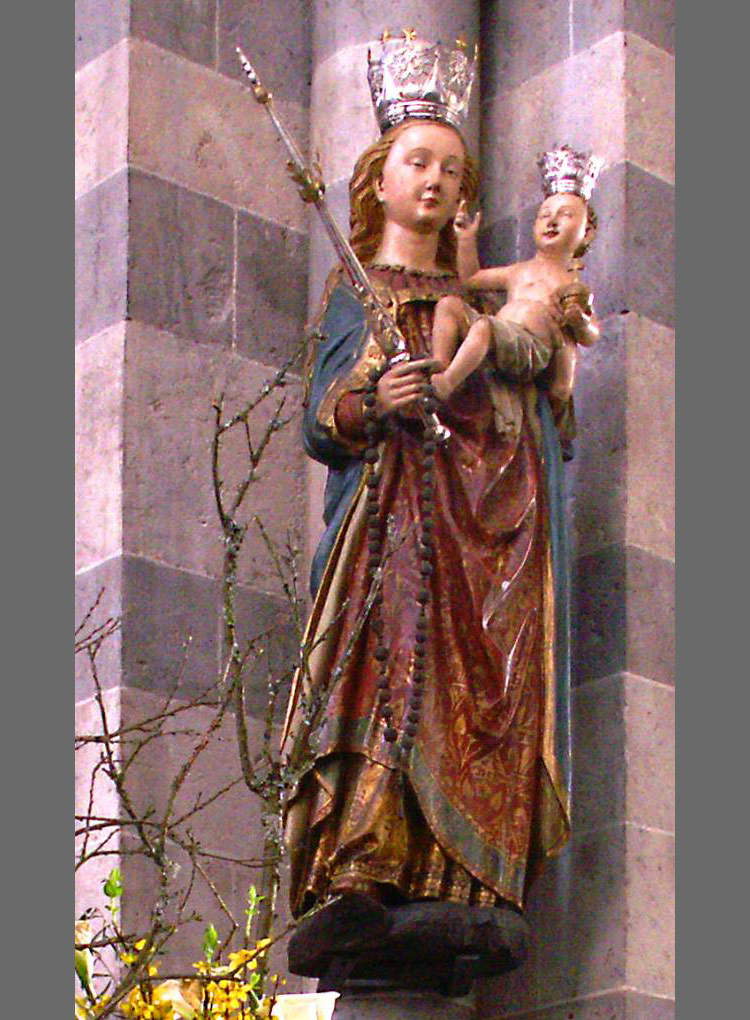 |
| German artist of the 15th century, Madonna of the Rosary (c. 1475; polychrone wood; Cologne, Sankt Andreas) |
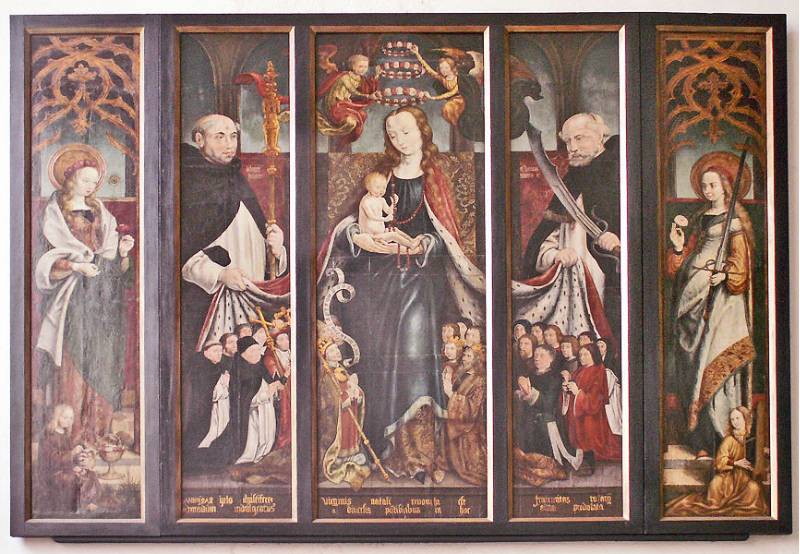 |
| Master of Sankt Severin, Madonna of the Rosary with Saints Dorothea, Dominic, Peter the Martyr and Cecilia (c. 1510; panel; Cologne, Sankt Andreas) |
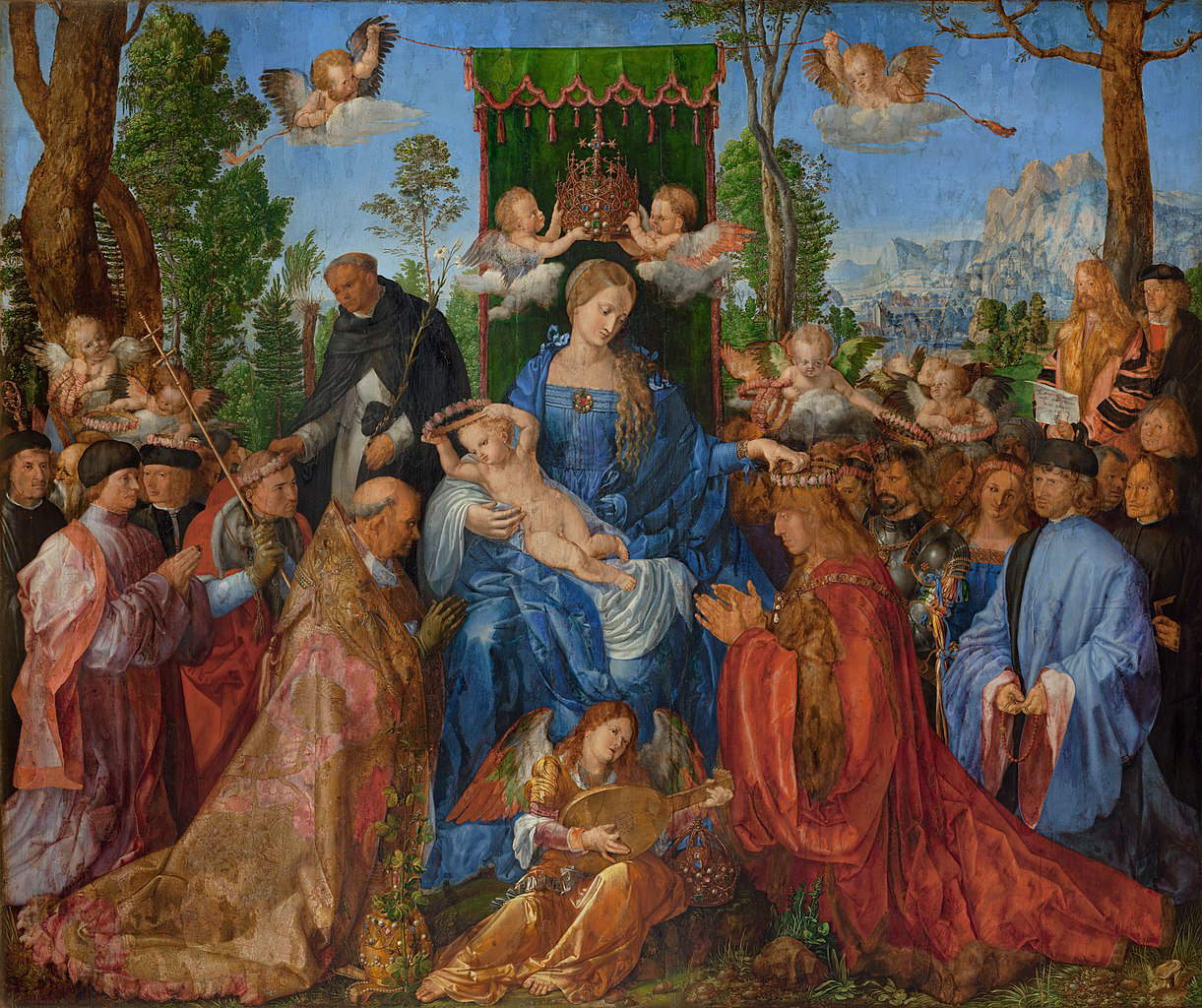 |
| Albrecht Dürer, Feast of the Rosary (1506; oil on panel, 162 x 194.5 cm; Prague, Národní Galerie) |
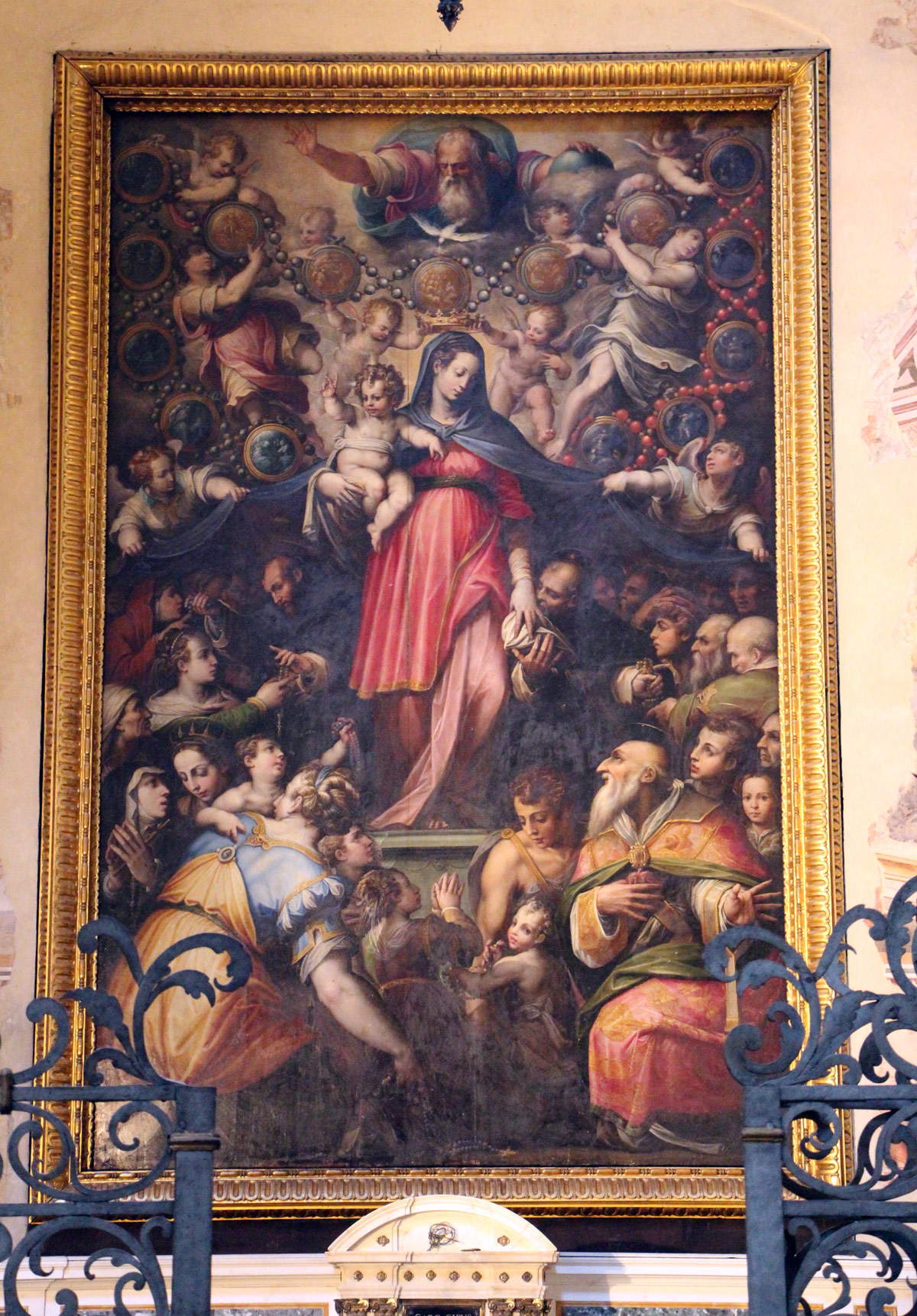 |
| Giorgio Vasari, Madonna of the Rosary (1570; panel; Florence, Santa Maria Novella). Ph. Credit Francesco Bini |
The fifteen Mysteries, which are divided into the Joyful Mysteries, the Sorrowful Mysteries and the Glorious Mysteries, are depicted on an imposing rose garden in Lorenzo Lotto ’s (Venice, 1480 - Loreto, 1556/57) masterpiece: the Madonna of the Rosary of Cingoli, executed for the town’s Dominican church and now housed in the Hall of Coats of Arms of the Cingoli Town Hall. The rose garden recalls the very etymology of the rosary (from the Latin rosarium, rosebush), as if each grain of the rosary was a rose to be dedicated to the Virgin Mary; in fact, the rose is considered the flower of the Madonna. The painting is one of the Venetian painter’s finest masterpieces; Lotto finished the large altarpiece in 1539. Beneath the large rose bush is depicted the enthroned Virgin with the Child on her knees; around her are saints in three orders celebrating her: saints Dominic and St. Esusperanzio (the former receives the rosary from Our Lady, the latter is the patron saint of Cingoli, a city represented by the same model toward which the Child leans). In the other orders, Mary Magdalene, Catherine of Siena, and finally the Dominican saints Vincent Ferrer and Peter of Verona are recognizable. The scene continues at the bottom, where we notice John the Baptist as a child together with two cherubs pointing to the Child Jesus, and one of the two cherubs is drawing rose petals from a wicker basket, another reference to the rosary.
Later, dating from the 1590s, however, is the altarpiece depicting the same Marian subject by Guido Reni (Bologna, 1575 - 1642). The Madonna of the Rosary with St. Dominic is kept inside the Basilica of San Luca in Bologna and features the traditional scene, less crowded than the previous one, of the handing over of the rosary beads to St. Dominic of Guzman by the Madonna and Child; in the lower part of the painting are found the medallions placed on a rose plant in which the fifteen mysteries are depicted.
Of a totally different approach, however, is the Madonna of the Rosary by Caravaggio (Milan, 1571 - Porto Ercole, 1610), a work preserved in the Kunsthistorisches Museum in Vienna. Executed in the early seventeenth century, the scene is built on a pyramidal form: at the top, in the center are the enthroned Madonna and Child; the Virgin appears to consent to the handing over of rosary wreaths by St. Dominic to the faithful, placed on the lowest level of the composition and depicted poor and kneeling with bare feet. On the opposite side of Saint Dominic, however, Saint Peter the Martyr is visible, with a scar on his forehead, in the act of pointing the viewer to the Virgin Mary. The scene depicted by Caravaggio appears elegant, and at the top, the wide red drape knotted to a column stands out brilliantly against Merisi’s characteristic dark tones.
To conclude the brief excursus on the Madonna of the Rosary in pictorial art, let us return to Luca Giordano (Naples, 1634 - 1705), to whose school belongs, as stated earlier, the famous and venerated Madonna of the Rosary of Pompeii. The Neapolitan painter painted his version of the Madonna of the Rosary in 1657, now housed in the permanent collections of the Capodimonte Museum. On a golden cloud supported by cherubs, the Madonna and Child gives into the hands of St. Dominic the rosary. Around, assisting the scene, are St. Francis and St. Nicholas of Tolentino on the left and St. Catherine of Siena, St. Teresa of Avila and Elizabeth of Hungary on the right. The composition follows the traditional iconography of Our Lady of the Rosary, with references to 16th-century Venetian painting, particularly Titian, in terms of luminosity and composition.
Unlike the Pompeii painting, the work in the Capodimonte Museum appears more detailed, objectively more beautiful to look at, but from a devotional point of view there is no comparison: every year more than four million people from all over the world will continue to go to the presence of Our Lady of the Rosary of Pompeii to ask for grace, to address their prayers to her. In fact, her cult is very much felt throughout Campania and the South, and her reproductions on stickers and objects of various kinds, as well as as as paintings on different scales, are widespread.
 |
| Lorenzo Lotto, Madonna of the Rosary (1539; oil on canvas, 384 x 264 cm; Cingoli, Palazzo Comunale) |
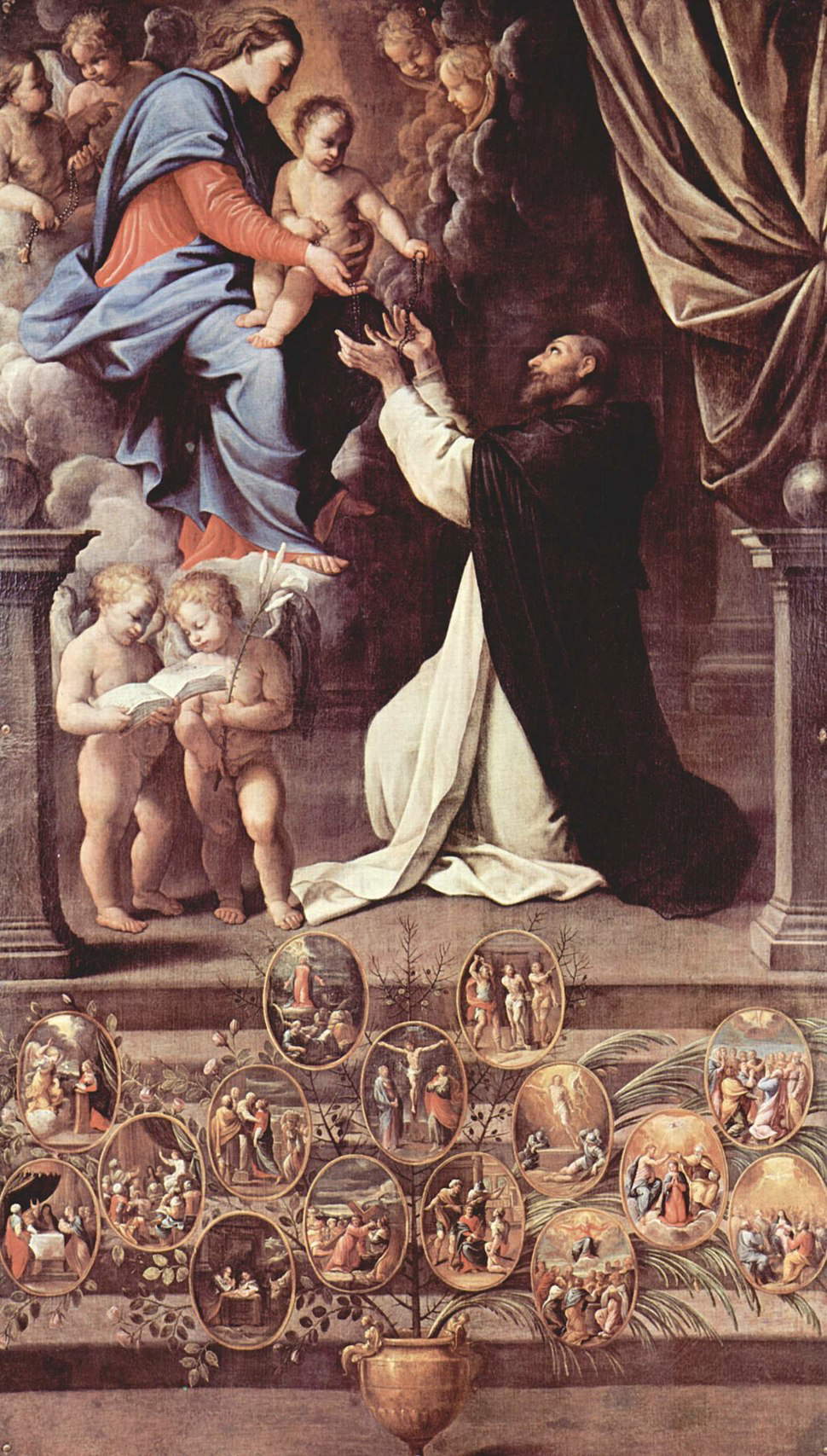 |
| Guido Reni, Madonna of the Rosary (1596-1598; oil on canvas, 390 x 220 cm; Bologna, Basilica di San Luca) |
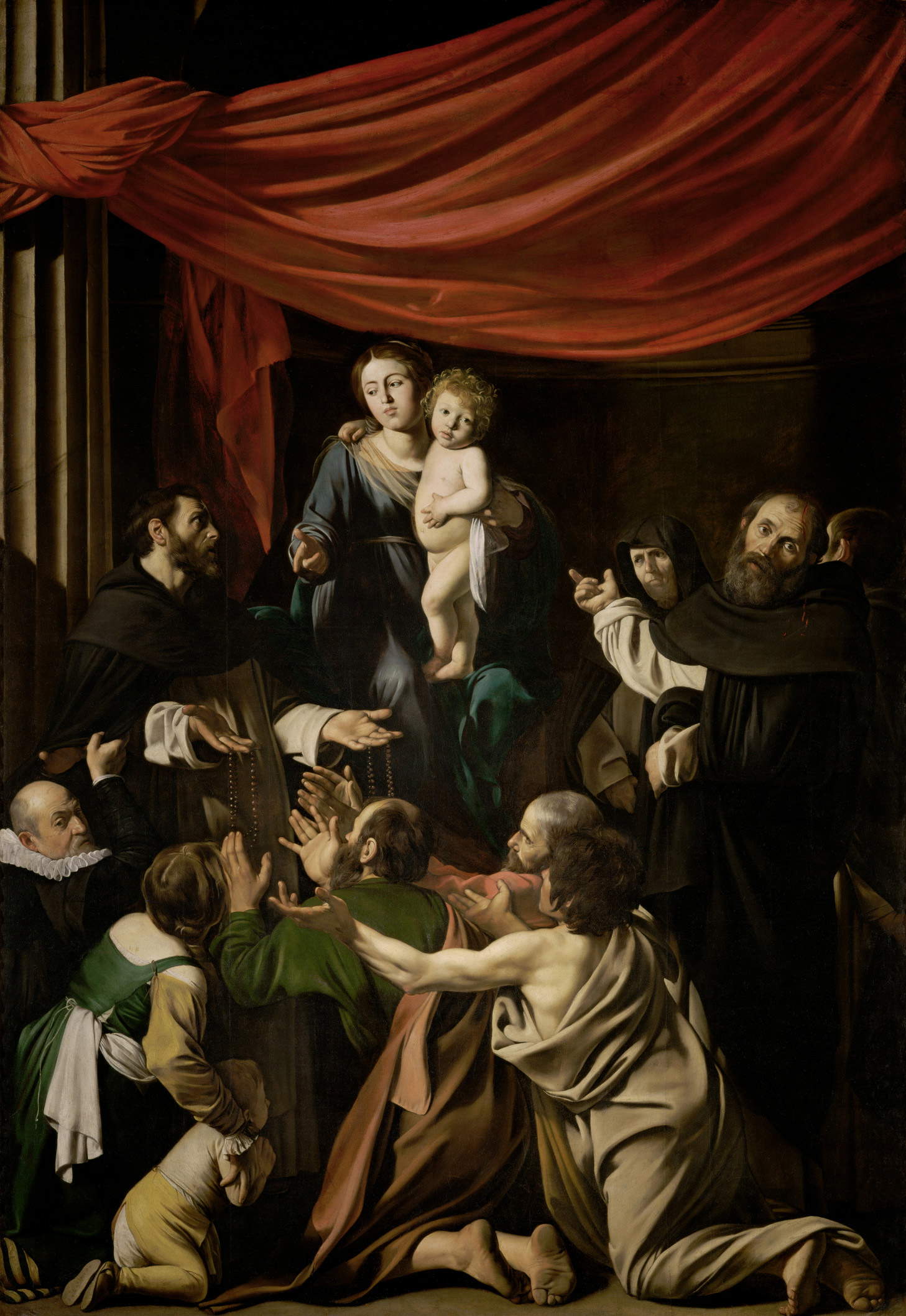 |
| Caravaggio, Madonna of the Ros ary (c. 1601; oil on canvas, 364.5 x 249.5 cm; Vienna, Kunsthistorisches Museum) |
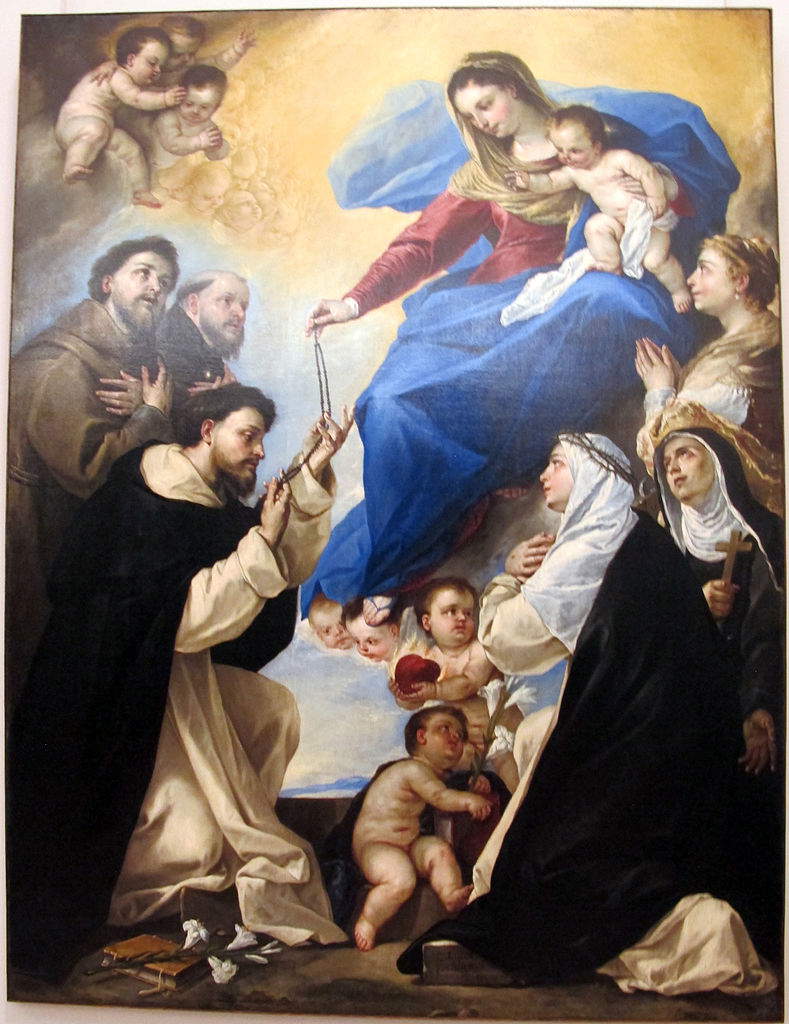 |
| Luca Giordano, Madonna of the Rosary (1657; oil on canvas, 253 x 192 cm; Naples, Museo Nazionale di Capodimonte). Ph. Credit Luca Giordano |
Warning: the translation into English of the original Italian article was created using automatic tools. We undertake to review all articles, but we do not guarantee the total absence of inaccuracies in the translation due to the program. You can find the original by clicking on the ITA button. If you find any mistake,please contact us.